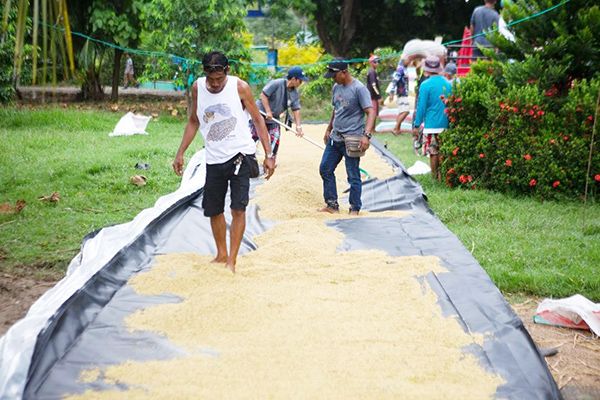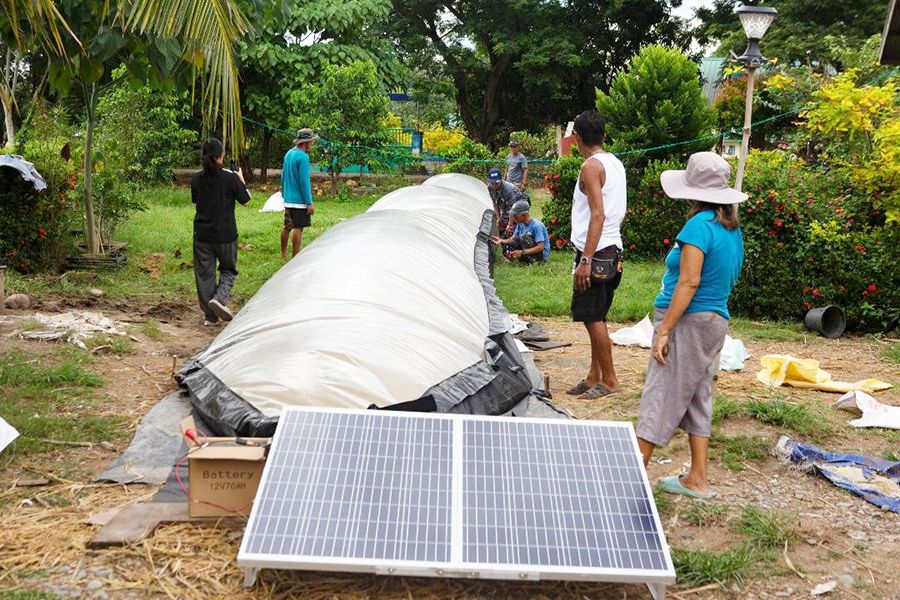Solar bubble dryers ease farmers' woes in Davao del Norte town
BRAULIO DUJALI, Davao del Norte – The month of September is known as harvest season in most of the rice-producing towns across the country.

FARMERS prepare to dry palay in the solar bubble dryer. (Keith Bacongco)
But as farmers are delighted to see the results of their three-month hard work, some are also struggling to hurdle the challenges from the lack of post-harvest facilities.
Among them is Mario Mandigal of Barangay Cabayangan here. Digal has been a farmer for over four decades and one of the certified seed growers in this rice-producing town.
But over the years, Mandigal and his fellow rice farmers have been facing a shortage of solar dryers not because they do not get any support from the government but due to lack of available spaces.
Municipal Agriculturist Officer Joey Ariola said that they have enough funding to build additional solar dryers. However, there are no available lands to build more post-harvest facilities.
For a seed grower, Mandigal emphasized the importance of having an available solar dryer as newly harvested certified seeds have to be dried within 24 hours.
“It’s really must to dry the newly harvested palay, especially for the certified seeds. Otherwise, it will be damaged and may no longer germinate,” said Mandigal, a certified seed grower for 12 years.
Thus, in the recent cropping cycle, Mandigal admitted that they were forced to reduce their production considering the lack of post-harvest facility. “We used to grow five hectares of certified seeds. But since we have experienced huge losses due to lack of post-harvest facilities, we were forced to reduce it to two hectares this time.”
During harvest season, he added, farmers here are racing against each other to dry their rice grains first in any available solar dryers.
Last year, he recalled, about P100,000 worth or 200 bags of certified seeds were damaged after the grains were not immediately dried.
“It so happened that all of the solar dryers here were occupied since it was harvest season. Our grains were stocked for a few days until we were able to dry them.“
However, it was too late. The damaged rice grains were instead turned for consumption instead of certified grains.
Each dried certified rice seeds costs at least P1,400 for every 40-kilo bag, Mandigal said.
No available spaces
Ariola has lamented the lack of available spaces to build additional solar dryers for years.
“We have enough funds from the government. However, there’s no available land to build the solar dryers. Sadly, most of our farmers are not willing to sell or donate a part of their land to be used for solar dryers,” Ariola said.
He confirmed that farmers are racing each other to dry their grains on solar dryers during harvest season.
As a result, many farmers are forced to dry their grains using tarpaulins if they run out of space in solar dryers, he added. “Some are forced to pay in privately owned mechanical dryers while some are also forced to sell their palay even if it’s still wet. That’s a big loss to farmers.”
Last February, the National Disaster Risk Reduction and Management Council reported that severe flooding affected at least 31,000 persons in this town of 35,000 people. Ariola said the flood affected 2,000 hectares of rice farms.
Solar bubble dryers
To help address the scarcity of solar dryers, humanitarian group Oxfam Pilipinas provided two solar bubble dryers that would benefit about 300 farmers in this town.
In partnership with Rural Development Institute of Sultan Kudarat (RDISK), the solar bubble dryers were part of Oxfam Pilipinas’ emergency response program following the massive flooding in the province last February.
Ariola said that the solar bubble dryers are very useful for the farmers here since they are now allowed to dry grains on the road.
For a seed grower, Mandigal said that the solar bubble dryers are a big help to minimize damages to the certified grains.

A SOLAR bubble dryer in Barangay Cabayangan, Braulio Dujali, Davao del Norte. (Keith Bacongco)
The solar bubble dryer is a collapsable tunnel-type dryer designed to dry agricultural commodities such as rice grains, coffee, monggo or mung beans, and corn.
Equipped with a pair of fans, it pumps air to vaporize moisture content of the grains into the exhaust port. It is also equipped with a battery to store power to enable farmers to dry grains even at night.
The solar bubble dryer, which is made of water-resistant materials, can accommodate up to half a ton of rice grains.
Mandigal was among the first farmers to use the equipment and was able to dry an initial of 15 sacks of certified seeds immediately after harvest. He added that it took about 48 hours to dry the 15 bags of certified seeds.
“The solar bubble dryer is ideal if you are a seed grower since you need to dry the grains immediately. We can dry the grains even if it’s raining, as long as it will not flood,” he said.
Eduardo Tarroza, president of the Magupising Irrigators Association here, admitted that aside from shortage of solar dryers, they are facing difficulties in drying their grains during the rainy season.
Even with limited capacity, Tarroza said solar dryers could still help them ease their problem. “We will just take turns since there are at least 160 farmers who belong to our association.”
Unlike conventional solar dryers, farmers admitted that sometimes it may take more than two days to dry their grains depending on the weather.
Mandigal emphasized the convenience of the solar bubble dryer as they don’t have to rush to cover the grains whenever there are sudden downpours. “We don’t have to worry also that our grains will be eaten by chicken and ducks because it’s covered.”